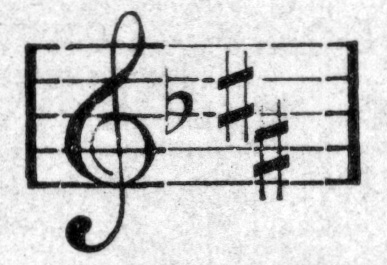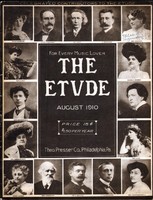Edited by LOUIS C. ELSON
Always send your full name and address. No questions will be answered when this has been neglected. Only your initials or a chosen nom de plume will be printed. Make your questions short and to the point. Questions regarding particular pieces, metronomic markings, etc., not likely to be of interest to the greater number of Etude readers will not be considered.
1. What does 8 under a note in the bass clef mean?
Usually it means with the octave below.
2. Are compositions ever written with both sharps and flats in the same signature?
Not in our scale system, but in other scales it is perfectly possible. Thus it occurs in Byzantine music. The Byzantine scale has intervals like our harmonic minor scale, with the fourth note sharp instead of natural. The Byzantine scale corresponding to our D minor would have G-sharp, B- flat, and C-sharp in the signature.
(See page 118 Hatherly’s “Byzantine Music.”)

3. Is the first note of a phrase always accented?
No. A phrase may begin in any part of a measure. But even if the accent does not fall upon the first note, it should be played clearly, and separated from whatever precedes it.
4. An argument has arisen between musicians here, and unanimously they hear the same phenomenon. When the soprano sings G and the tenor or baritone sings C in the G clef, it sounds a fifth. But if tenor sings C from tenor clef, or baritone from bass clef, it sounds a fourth. Why do the clefs change the pitch of the notes, though by their notation there should be no change? (Acoustician.)
If all are singing in the same composition, with accompaniment of instruments or even without it, the interval would always sound a fifth. It would never sound a fourth unless the tenor or baritone were singing in a different system of pitch from the soprano. The voice is not treated as a transposing instrument, and the singers must not, therefore, sing a tone higher than the note is written.
5. What is the correct pronunciation of the words “wind” and “windy?” (Etudian.)
The Century Dictionary makes the “i” short, but says that it is often long in poetry. But Tennyson, most musical of poets in diction, preferred the short “i.” Since there is a doubt, the singer may remember that the long “i” is easier to sing. The present writer considers the short “i” correct, as the long “i” doubtless arose from forced rhymes. Thus Whittier wrote : “Of all sad words of tongue or pen, The saddest are these:—It might have been.”
But we do not call a pen a pin, nor do we pronounce been like Ben. I should always prefer the short “i” in “wind” or “windy” unless it disturbed a rhyme.
6. What chord is a 5-4-2? For example, G-C-D-A following the tonic triad of G? How many inversions of the chord of the ninth, and how designated? Am I right in designating A-C-sharp-G-B as the chord of the dominant ninth of D (fifth omitted)? What interval is C-G-double-flat ? Is the small half-step the smallest interval used in music? (Ignoramus.)
G-C-D-A would be a 5-4-2 chord, as suggested. In close position, the A would come after the G. There are four inversions of the chord of the ninth, sometimes called the first, second, third, and fourth inversions, and sometimes called the b, c, d, and e positions, the chord itself being the a position. Your ninth chord is correctly named. From C to G-double-flat, or C-sharp to G-flat, is called a doubly diminished fifth. The half-step is the smallest interval used in our music, but in India the natives use third- and quarter-tones in their music.
7. In Schumann’s “Traümerei,” in the left hand, where the appogiatura runs into the half note, should the A be struck again, in the chord or held over as a tied note from the appogiatura? What is the correct pronunciation of Traümerei? (H. B. B., Cal.)
The A is tied to the half-note, just as the F is, in the second measure. The name of the piece is pronounced Troy-myrrh-eye, with the accent on the last syllable.
Q. What is a nail-fiddle, and who invented it? (L. O. C.)
A. The nail-violin was invented in 1740 by Johann Wilde, a German, living in St. Petersburg. The idea came to him through his accidentally scraping a bow on a metal peg and producing a tone. The nails are placed around the curve of a wooden sounding-board shaped like a half-moon. The shorter nails give higher tones, and those for chromatic intervals are bent slightly. The instrument is played with a strong, well- rosined, black-haired bow. In 1780 sympathetic strings were added. In 1791 an oblong- shaped “nagelclavier” was made by Trager, of Bamberg. This was played by a band coated with rosin and worked by keys.
Q. What relation does the miracle play bear to the oratorio? (G. 0.)
A. The oratorio came almost directly from the miracle play. The earliest miracle play of which we have authentic records is the “Festum Asinorum,” celebrated at Beauvais and Sens in the twelfth century. Fitz Stephen mentions a monk of Canterbury who wrote miracle plays during the reign of Henry II, and died in 1191. In later times “Il Conversione di San Paolo” was sung at Rome in 1440, and “Abram et Isaac suo Figluolo” at Florence in 1449. Over a century later St. Philip Neri, in Rome, had sacred music scenes or plays given in connection with his discourses. As they were given first in the oratory of his new church (Santa Maria, in Vallicella), they were called oratorios, and that name soon became the accepted term for sacred musical dramas. Emilio del Cavalieri is called the founder of modern oratorio, because his “Rappresentazione dell’ Anima e del Corpo” (Rome, 1600) was the first sacred work in the monodic style which Peri and Caccini introduced in opera. All preceding oratorios belonged to the contrapuntal schools.
Q. Who is the greatest pianist living? (I. T. F.)
A. If this question were put to the pianists probably a different answer would come from each one. Thus, in ancient Athens, when the leaders were choosing a commander to proceed against the Persians, each one voted for himself; but, as almost all voted for Themistocles as second choice, he was declared elected. Critics are fairly well united in considering Paderewski the greatest living pianist. There are some who excel him in certain special lines—De Pachmann, for instance, in the smaller Chopin works ; D’Albert in Beethoven playing, or Busoni in Bach. But Paderewski is thoroughly versatile, being great in every style and school, and very little behind any of the others, even in their own specialties. But it is as dangerous to choose the “greatest living pianist” as to pick out the most beautiful infant in a baby show.
Q. Did opera precede oratorio, or is it derived from oratorio? (O. N. K.)
A. Oratorio really preceded opera. Opera resulted from the efforts of a group of Florentine amateurs (the “Camerati”) to revive something like the ancient Greek drama. The foremost of these were Peri and Caccini. Peri’s. “Dafne” was brought out probably in 1594, but was lost, so that his “Euridice” (1600) is considered the first opera. Oratorio was at first acted and sung in costume, and it is quite possible that it influenced the early operas, although we have no absolute proof of this.
Q. Are there any choral societies in America which compare favorably with those in Germany or England? (Observer.)
A. Yes; the Apollo Club of Boston or Chicago, for instance. The English lay great stress on their festival choruses, but the Mænnerchor of Germany deserves recognition for its heartiness and sincerity, even if sometimes lacking in polish.
Q. When was the bugle first used for military purposes? (Etude Reader.)
A. The bugle is really prehistoric, for bronze trumpets of the Bronze Age have been discovered. In ancient Jerusalem the ram’s horn was used. In Roman times the war trumpet was called Buccina.
Q. When were pedal attachments first used on organs? (Young Organist.)
A. Lootens gives a description of a Dutch organ, with pedals, said to have been built at Utrecht in 1120. But pedals remained in a rather primitive state until the improvements of the fifteenth century.
Q. Where is the finest peal of bells in this country? (L. R.)
A. Probably the best set of chimes in this country is the one at the Christian Science church in Boston. The bells are tubular in shape, and are played by a keyboard with electrical connections. They have proven so effective that several duplicate sets have been ordered for other places.
Q. What syllables would one give to double sharps and double flats in singing according to the French system of using a fixed do? (H. T.)
A. In the French system of solfeggio, the syllables do, re, mi, etc., are not changed for accidentals. In instrumental music, double sharp is double dieze, and double flat is double bemol.
Q. How many colored opera companies ever existed? What opera or operas could be best rendered (that is, most artistically) by a company of well-trained colored singers and musicians? (R. H. B.)
A. Several colored opera companies have existed, including the one in which the “Black Patti” appeared. Most of them have given only light opera or musical comedy; but there is no reason why a colored company should not give any opera. The success should depend on the ability of the singers. The simplest operas should be the best to begin with, such as “Trovatore” and others of its school, or comedies like “Don Pasquale” and “L’Elisir d’Amore.” Other good comedies are “Czar und Zimmerman,” “Die Fledermaus” and “The Daughter of the Regiment.”



